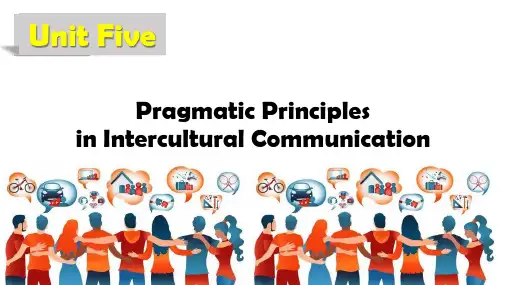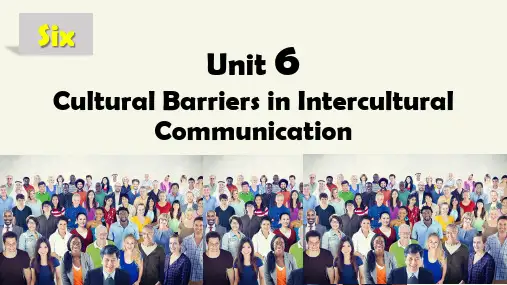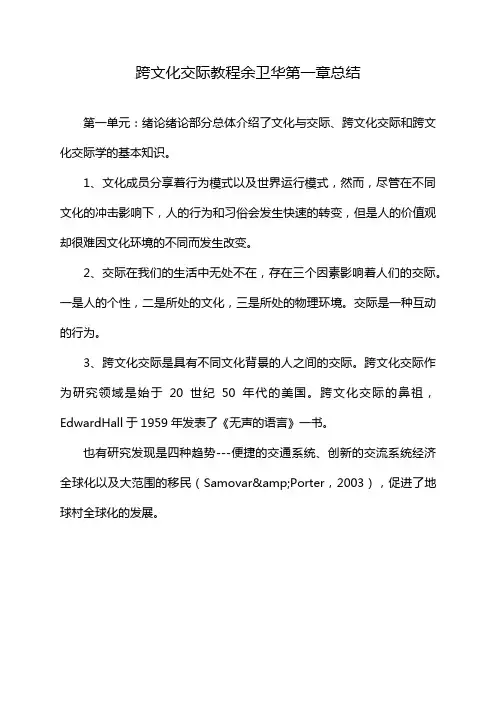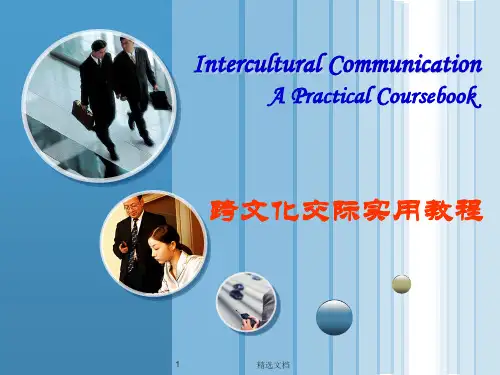跨文化交际教程
- 格式:ppt
- 大小:152.00 KB
- 文档页数:11


跨文化交际教案(5篇范文)第一篇:跨文化交际教案黑龙江大学文学院对外汉语专业必修课程《跨文化交际》主讲人:殷树林电子信箱:*****************第一章文化与交际一、文化“文化”是跨文化交际学中的核心因素之一,有必要界定它的概念。
文化的定义是中外学者们争论不休而又见仁见智的问题。
“横看成岭侧成峰,远近高低各不同”。
从1871年文化人类学的创始人英国学者泰勒(E.B.Tylor)提出文化的定义以来,学者们从不同的学科角度出发给文化下定义,至今有150多种之多。
尽管这是个令人头疼的问题,但是作为本学科的基础研究对象之一,我们又必须面对它。
(一)文化的概念1、文化一词的来源。
在我国古籍中,“文”既指文字、文章、文采,又指礼乐制度、法律条文等;“化”是“教化”的意思。
汉代刘向在《说苑》中说:“凡武之兴,为不服也,文化不改,然后加诛”。
“文化”与“武功”相对,含教化的意思。
在西方,“文化”一次来源于拉丁文cultura,在英文中为culture,原义是指农耕以及对植物的培育,从15世纪以来,逐渐引申为对人的品德和能力的培养。
在近代,日本人把英文的culture翻译成文化,我们又借用了日本人的译法。
(经济,编辑,逻辑,主义等等)文化一词的中西两个来源,殊途同归,今人都用来指人类社会的精神现象,或泛指人类所创造的一切物质产品和非物质产品的总和。
2、文化概念的界定。
文化是社会学和人类学的一个基本概念。
中国学者对文化的界定为:广义的文化是指人类创造的一切物质产品和精神产品的总和;狭义的文化专指包括语言、文学、艺术以及一切意识形态在内的精神产品。
西方学者对文化的各种界定中,美国文化人类学家克罗伯和克鲁克洪在1952年发表的《文化:一个概念定义的考评》中提出的定义为多数人所接受。
他们在分析了100多种文化定义后,把文化定义为:文化存在于各种内隐和外显的模式之中,借助于符号的运用得以学习和传播,并构成人类群体的特殊成就,这些成就包括他们制造物品的各种具体式样,文化的基本要素是传统(通过历史衍生和由选择得到的)思想观念和价值,其中尤以价值观最为重要。


跨文化交际教程余卫华第一章总结
第一单元:绪论绪论部分总体介绍了文化与交际、跨文化交际和跨文化交际学的基本知识。
1、文化成员分享着行为模式以及世界运行模式,然而,尽管在不同文化的冲击影响下,人的行为和习俗会发生快速的转变,但是人的价值观却很难因文化环境的不同而发生改变。
2、交际在我们的生活中无处不在,存在三个因素影响着人们的交际。
一是人的个性,二是所处的文化,三是所处的物理环境。
交际是一种互动的行为。
3、跨文化交际是具有不同文化背景的人之间的交际。
跨文化交际作为研究领域是始于20世纪50年代的美国。
跨文化交际的鼻祖,EdwardHall于1959年发表了《无声的语言》一书。
也有研究发现是四种趋势---便捷的交通系统、创新的交流系统经济全球化以及大范围的移民(Samovar&Porter,2003),促进了地球村全球化的发展。




新编跨文化交际英语教程知识点梳理(实用版)目录1.新编跨文化交际英语教程的概念与目的2.跨文化交际的重要性3.新编跨文化交际英语教程的主要内容4.新编跨文化交际英语教程的特点与亮点5.新编跨文化交际英语教程的应用与实践正文一、新编跨文化交际英语教程的概念与目的新编跨文化交际英语教程是一本针对英语学习者的教材,旨在帮助学生更好地理解和应对跨文化交际中的各种问题。
该教程通过讲解文化、交际、语言以及跨文化交际等相关概念,使学生能够较为客观、系统、全面地认识英语国家的文化,从而提高跨文化交际能力。
二、跨文化交际的重要性随着全球化的不断深入,跨文化交际在我们的生活中扮演着越来越重要的角色。
对于英语学习者来说,掌握跨文化交际的能力不仅能够帮助他们更自信地与来自不同文化背景的人进行交流,还能够拓宽他们的国际视野,提高他们的综合素质。
三、新编跨文化交际英语教程的主要内容新编跨文化交际英语教程共分为 10 个单元,涵盖了全球化时代的交际问题、文化与交际、各类文化差异、语言与文化、跨文化言语交际、跨文化非言语交际、时间与空间使用上的文化、跨文化感知、跨文化适应、跨文化能力等各个方面。
每个单元都以阅读文章为主线,配有形式多样的练习和数量较多的案例分析,同时还提供丰富的相关文化背景知识材料,供选择使用,以满足不同的教学情境和需求。
四、新编跨文化交际英语教程的特点与亮点新编跨文化交际英语教程具有以下特点和亮点:1.实用性:教材选材广泛,包括了几十个实例,既有趣味性,又有实用性,能够帮助学生在实际交际中更好地运用所学知识。
2.系统性:教程对跨文化交际的各个方面进行了全面、深入的讲解,使学生能够系统地掌握跨文化交际的知识和技能。
3.灵活性:教材形式多样,既有阅读文章,又有练习和案例分析,能够满足不同学生的学习需求和教学情境。
4.丰富性:教材提供了丰富的相关文化背景知识材料,帮助学生更好地理解和感知英语国家的文化。
五、新编跨文化交际英语教程的应用与实践新编跨文化交际英语教程在实际应用中,可以通过以下方式进行实践:1.在课堂教学中,教师可以结合教材的内容,进行跨文化交际的讲解和训练,帮助学生提高跨文化交际能力。



跨文化交际英语教程课后答案【篇一:新编跨文化交际英语教程_参考答案unit 6 】ture and nonverbal communicationreading ian overview of nonverbal communication comprehensionquestions1. can you speak each of the following sentences in differentways to mean differently?1) she is my best friend.2) you?ve done really good job. 3) come here,please.4) that?s all right.speaking the same sentence with the stress on differentwords may mean different things. for instance, if the stressfalls on “she”in the first sentnece, it means it is she, not youor somebody else, that is my best friend. but if the stress fallson “my”, it implies that she is my, not your or somebody?sbest friend.2. speakers of british english use loudness only when theyare angry, speakers of indian english use it to get the floor, achance to speak. so when an indian speaker is trying to get thefloor, what would the british speaker think of the indian andwhat would the british behave in response?the british speaker may think that the indian gets angry withhim or behaves rudely towards him, so he may complain aboutthe indian?s rudeness or even return his rudeness as aresponse.3. what differences in body language use have you noticedbetween your chinese teachers and foreign teachers?there are really some differences between chinese teachersand foreign teachers in their use of body language. forinstance, chinese teachers in general do not use gestures asmuch as foreign teachers do, and their facial expressions oftenseem to be less varied than those of many foreign teachers.4. do you know any gestures we often use that might bemisunderstood by people from other cultures?for example, the way we chinese motion to others to come over might be misunderstood by people from some western countries to mean bye-bye.5. how do we chinese people use eye contact in communication?during a conversation between two chinese, it seems that the speaker and the hearer would usually look at each other (not necessarily in the eye) from time to time. how much eye- contact there is may depend on the relationship between the speaker and hearer and the situation they find themselves in.6. how will you eye them when you are communicating with people from the united states or people from japan?while talking with americans, we should look directly into the eyes of the person with whom we are talking. however; while talking with japanese, we are not expected to look at them in the eye but at a position around the adam?s apple.7. do you often smile at others? why or why not?it depends. for instance, it seems that we chinese, as well as people of other eastern asian countries, do not usually smile at strangers as much as americans.8. what function(s) may laughter serve in our culture? does it sometimes cause intercultural misunderstanding?laughter in our culture may serve various functions. sometimes, it is used to express amusement or ridicule, and sometimes it is simply used to make one feel less embarrassed.9. do you often touch others while talking with them? whom do you touch more than others?we chinese generally do not often touch others while talking with them unless they are our intimate friends or younger children.10. in small groups or in pairs, demonstrate all the possible ways you can think of to greet another person. is touching always part of a greeting?no. touching is not always part of a greeting in our culture as in some other cultures.11. will you apologize if you accidentally touch other people in public places? why or why not?many people will apologize if they accidentally touch other people in public places since in our culture people who arestrangers to each other should not touch. however, whetherpeople will apologize or not depends on the situations. if aperson accidentally touches a stranger in a very crowdedplace, he or she may not apologize for it.reading iigender and nonverbal communication comprehensionquestions1. what may often happen to those who do not conform totheir culture?s accepted gender “script ”?there are often severe social penalties for those who act inviolation of their culture?s accepted gender ―script.2. does touch have any connotation in different situations?can you give some specific examples?touch, like physical closeness, may be considered anexpression of affection, support, or sexual attraction. forinstance, in some cultures, it may be all right for womenfriends and relatives to walk arm-in-arm, dance together, andhug one another, but if men do so, they may be frowned upon,for it would be considered as having the connotation of being homosexual.3. what will possibly happen to a woman who is appreciablytaller than the man?taller women may attempt to diminish themselves, to slouchand round their shoulders so as to retreat or to occupy as littlespace as possible.4. are men and women required to have the same facial expressions? does smile mean the same things to both menand women?men and women are not usually required to have the samefacial expressions. smile may mean different things to menand women. for females smile functions as an expression of pleasure, pleasantness, or a desire for approval, while malesmay resist any nonverbal display of expression to others inorder to appear more masculine, because being faciallyexpressive is often seen as a marker of ―femininity.5. why are the african-american women less deferential thanwhite women and less inclined to smile?african-american women are found to be less deferential thanwhite women and, therefore, less inclined to smile, simplybecause it is expected of them to be so in their culture.6. in what ways may direct eye contact between individualsbe interpreted?looking directly into another person?s eyes can connote an aggressive threat, a sexual invitation, or a desire for honestand open communication.7. what was found in a study of nonverbal communicationamong hispanic couples? in a study of nonverbalcommunication among hispanic couples, it was found thatmany puerto rican wives never looked directly at theirhusbands.8. how does clothing manifest and promote culturaldefinitions of masculinity and femininity?through clothing and make-up, the body is more or lessmarked, constituted as an appropriate, or, as the case may be, inappropriate body for its cultural requirements. males andfemales have to dress themselves appropriately according totheir cultural definitions of masculinity and femininity.case studycase 21sometimes our best intentions can lead to breakdowns ( 故障) in cross-cultural communication. for example, one of the verycommon manners of touching --- handshaking --- may result inconflict when performed with no consideration of cultural differences. among middle-class north american men, it iscustomary to shake hands as a gesture of friendship. whenwanting to communicate extra friendliness, a male in theunited states may, while shaking hands, grasp with his lefthand his friend?s right arm. however, to people of middleeastern countries, the left hand is profane ( 亵渎的) and touching someone with it is highly offensive. therefore, invernon?s eyes, kenneth was actually an extremely offensivemessage to him.case 22in puerto rican culture, as in some other latin american andeastern cultures, it is not right for a child to keep an eye-contact with an adult who is accusing him or her, while in theunited states, failing of meeting other person?s eye accusinghim or her would be taken as a sign of guiltiness. as theprincipal knew little about this cultural difference in using eye-contact, he decided that the girl must be guilty. generallyspeaking, avoiding eye-contact with the other(s) is oftenconsidered as an insult in some cultures, but may signifyrespect for authority and obedience in other cultures.case 23just like smile, laughing does not always serve the samefunction in different cultures.interestingly, for us chinese, laughing often has a specialfunction on some tense social occasions. people may laugh torelease the tension or embarrassment, to express theirconcern about you, their intention to put you at ease or to helpyou come out of the embarrassment. in this case, the peoplethere were actually wishing to laugh with the american ratherthan laugh at her. their laughing seemed to convey a numberof messages: don?t take it so seriously; laugh it off, it?snothing; such things can happen to any of us, etc. unfortunately the american wasunaware of this. she thoughtthey were laughing at her, which made her feel more badly andangry, for in her culture laughing on such an occasion wouldbe interpreted as an insulting response, humiliating andnegative.case 24it is obvious that there exists some difference between thebritish and germans in their use of touch. the lack of touch thatseems to be natural in britain may be considered strange bygermans. what is required (in this case, shaking hands witheach other) in one country could be taken as unnecessary inanother.the appropriateness of contact between people varies fromcountry to country. figures from a study offer some interestinginsight into this matter. pairs of individuals sitting and chattingin college shops in different countries were observed for atleast one hour each. the number of times that either onetouched the other in that one hour was recorded, as follows: inlondon, 0; in florida, 2; in paris, 10; in puerto rico, 180. thesefigures indicate that touch is used very differently in differentcultures.【篇二:新编跨文化交际英语教程答案详解】很显然,文化间以及亚文化间的交往比以前多了,这迫切要求我们共同努力,去理解有着不同信仰和文化背景的人们,并与之和睦相处。
跨文化交际实用教程Unit引言在当今全球化的时代,跨文化交际变得越来越重要。
随着技术的进步和交通的发展,不同国家、不同文化之间的交流日益频繁。
然而,由于不同文化之间存在差异,跨文化交际也面临着种种挑战。
本教程将提供一些实用的技巧和策略,帮助读者更好地应对跨文化交际的挑战。
1. 跨文化意识的重要性在进行跨文化交际之前,了解不同文化之间的差异变得至关重要。
跨文化意识是指对不同文化的认知和敏感度。
具备跨文化意识能够帮助我们更好地理解不同文化的行为规范、价值观和沟通方式。
为了培养跨文化意识,我们可以采取以下措施:•学习其他文化的历史、宗教和价值观等方面的知识;•保持开放心态,尊重和包容不同的文化观点;•结交来自不同文化的朋友,增加跨文化交流的机会。
2. 语言和非语言沟通语言是跨文化交际中最基本的工具。
不同的语言代表着不同的文化,所以在跨文化交际中要注意语言的选择和使用。
以下是一些语言沟通的技巧:•使用简洁清晰的语言表达自己的观点;•避免使用俚语、口头禅和难以理解的专业术语;•注意语调和语速,避免过于迅速或过于慢的语速。
除了语言,非语言沟通也是跨文化交际中不可忽视的部分。
姿势、面部表情和身体语言等可以传达丰富的信息。
以下是一些非语言沟通的技巧:•保持姿势放松和自然,不要过于僵硬或放松;•注意对方的面部表情和眼神,以理解他们的情绪和意图;•避免在不同文化下可能引起误解的非语言符号。
3. 尊重文化差异在跨文化交际中,尊重和包容不同文化的差异是非常重要的。
不同文化之间存在着迥然不同的价值观和行为规范,我们应该尊重并理解这些差异。
以下是一些尊重文化差异的建议:•避免对其他文化的偏见和歧视,保持开放心态;•倾听和尊重他人的观点,不轻易做出评判;•学会接受和适应其他文化的习俗和方式。
4. 跨文化冲突和解决尽管我们尽力尊重和理解不同文化之间的差异,但跨文化冲突仍然是不可避免的。
当面临跨文化冲突时,我们可以采取以下措施来解决问题:•试图理解对方的观点和利益,寻找共同点;•通过积极的对话和交流,寻求共识和解决方案;•寻求第三方的帮助和调解,以实现和平解决冲突。
大学英语跨文化交际教程课后答案(全)-CAL-FENGHAI.-(YICAI)-Company One1Unit1 Sportsmanship: It is the ability to practise a sport according to its rules, while also showing generosity to one’s opponent and good temper in defeat.2. Traditionally, an Englishman is thought to be reserved, unemotional, courteous, shy of strangers, suspicious of change, and slow to accept new ideas.3. It is the ability to practise a sport according to its rules, while also showing generosity to one’s oppo nent and good temper in defeat. Moreover, sportsmanship as an idea is applied to life in general.The pioneering spirit: Except for the brought from Africa, immigrants came to America voluntarily, early in search of greater prosperity and freedom.Rags-to-riches: It is story about a poor boy who, because he was hardworking, honest, and lucky, grew up to become rich and respected.American dream: The belief that any individual, no matter how poor, can achieve weather and fame through diligence and virtue.1. Traditionally, individualism, independence and collaboration, practice, tolerance, melting pot and racial discrimination are the character of Americans.3. The American Dream is the belief that any individual, no matter how poor, can achieve wealth and fame through diligence and virtue.Unit 2 Key concepts Five relationships Five relationships: ruler-minister, father-son, husband-wife, elder-younger brother and friend-friend.Humanism Humanism means that man not only had the right to enjoy the beauty of their life, but also had the ability to perfect themselves and perform wonders. Individualism An individualism culture is one in which people tend to view themselves ad individuals and to emphasize the needs of individuals.Collectivism A collectivism culture is one in which people tend to view themselves as members of groups (families, work units, tribes, nations), and usually consider the needs of the group to be more important than the needs of individuals. Comprehension questions1.According to Confucianism, what are the five cardinal relationships in Chinese society and what should these relationships be?That is the well-known five relationships: ruler-minister, father-son, husband-wife, elder-younger brother and friend-friend. This was explained as" There should be affection between man and wife, stratification between old and young, and good faith between friends."2.What is the difference between collectivism and individualism?Firstly, westerns tend to believe that people should rely on themselves as much as possible- and they usually expect other people to do the same. So they don't think they have the obligation to help family members and friends during emergency situations. In contrast, people in collectivist cultures generally feel that they have a right to help other members of their groups.Secondly, westerns generally feel that the rights of individuals should not be subordinated to the needs of a larger group, or at least that individuals should have the right to decide for themselves whether to sacrifice their personal benefit for the sake of the group. In contrast, people in collectivist cultures are generally more willing to accept the idea that individuals should sacrifice for the benefit of the group.Thirdly, westerners tend to believe that individuals should make decisions for themselves, and that individuals should take credit and responsibility for what they have personally done. In contrast, people in collectivist cultures tend to feel more that they are representatives of their group, and to accept more responsibility for the other members of their groups too.A final difference lies in the way people in different cultures view the idea of "individualism". Westerners tend to view individualism as a good thing. In contrast, the Chinese term for "individualism", often has a somewhat negative connotation, and is sometimes used as a synonym for "selfishness."Unit3 Nuclear family: include a husband, a wife and their childrenExtended family: adult couples are expected to form their own household with either of their biological families.2. Because they desire a close and intense bond with their partners,they expect so much from marriage that so many get divorcedImpermanence: the property of not existing for indefinitely long durations. Stable: resistant to change of position or conditionConnection vs. contract: relationship4. ①Chinese are likely to react more to the other person as a whole and will avoid forming friendships with those values and behaviors are in some way deemed undesirable. ②In China a friend is accepted completely or not at all ③Chinese friends give each other much more concrete help and assistance than Western friends do.①American have casual, friendly relationships with many people, but deeper, closer friendships with only a few. ②American friendships tend to be verycom partmentalized. ③American friendships is mostly a matter of providing emotional support and spending time together.Unit5 Nutrition and balance: a look at the nutritional information, like the number of calories preserving, grams of fat, sodium, cholesterol, fiber and sugar content will make you more knowledgeable in selecting foods to reduce your nutritional health risk.Pragmatism:in the westerns’ eyes, food or eating is just a way to keep healthy, having little to do with artistry. Nor will they be particular about the taste of food too much.Unit6 Creativity: the ability to createSelf-reliance: is a principal value of child rearing in middle-class American. Originality:1.How do the Chinese teach their children?A: Chinese teach their children by holding their handsHow do Americans do?A: On their own and even to discover new problem for which creative solutions are wanted.Can you find the theories supporting the two different teaching method?A: Evolutionary and revolutionary2. Can you tell any other differences between the two educational systems?A: The contrast between the two cultures can also be seen in the fears we both harbor. Chinese teachers are fearful that if skills are not acquired early, they may never be acquired; there is, on the other hand, no comparable hurry to promote creativity. American educators fear that unless creativity has been acquired early, it may never emerge; on the other hand, skills can be picked up later.Unit7 Key concepts Monochronic time Monochronic time is an approach that favors linear structure and focus on one event or interaction at a time. Polychronic time A polychronic time system is a system where several things can be done at once, and a more fluid approach is taken to scheduling time. Unlike Americans and most northern and western European cultures, Latin American and Arabic cultures use the polychromic of time.Linear structure In monochromic time, linear structure means people focus on one event or interaction at a time.Schedule oriented People in polychronic time cultures treat time as a less tangible medium so that they can interact with more than one person or do more than one thing at a time.People oriented Polychronic individuals are oriented toward people, human relationships, and the family, which is the core of their existence. Family takes precedence over everything else, close friends come next..Comprehension questionsWhat is monochronic culture What is polychronic cultureMonochronic cultures typically emphasize doing one thing at a time during a specified time-period, working on a single task until it is finished.Polychronic cultures are involved with many things at once, usually with varying levels of attention paid to each.What are the different attitudes monchronic people and polychronic people hold toward time?Monochronic people see time as being divided into fixed elements (seconds, minutes, hours, etc.)Sequential blocks that can be organized, quantified, and scheduled.What are the strengths and weaknesses of M-time system and P-time system? Once the time is set, it is rarely changed, and people take it seriously. M-time cultures is one who violates the rule of punctuality shall be punished seriously. Matters in a polychronic plans for the future: even important plans maybe changed right up the minute of execution.Unit 9Key concepts High-context culture High context cultures rely on the context, either the actual physical environment of communication or an internalized social context or both, or convey a large part or even all of a message’s meaning.Low-context culture Low context culture, in which context is not assumed to be understood, messages are explicit, direct, and completely encoded in words, and meaning is entrusted almost entirely to words.ImplicitnessThe message which someone expressed is elliptical, indirect, and allusive.Explicitness The message which someone expressed is direct, and completely encoded in words, and meaning is entrusted almost entirely to words.. Verbalizing Verbalizing- that is, to put things in words, whether written or oral. Comprehensive questionsWhat is High-context culture What is Low-context cultureHigh context cultures rely on the context, either the actual physical environment of communication or an internalized social context or both, or convey a large part or even all of a message’s meaning.Low context culture, in which context is not assumed to be understood, messages are explicit, direct, and completely encoded in words, and meaning is entrusted almost entirely to words.ImplicitnessWhat does silence mean in high-context cultures What is the function of silence in high-context cultures It means entirely accepted.In the individual level, silence can be viewed as a state of being allowing you to experience the highest truth and bliss; on the interpersonal level, silence can be used to promote harmony, cooperation, and other collectivistic values; on the level of social movements, silence can be protest.Why does silence mean differently in different culturesDifferent in the uses of silence can be best examined in high-context and low-context cultures. High-context cultures are relational, collectivist, intuitive, and contemplative. Low-context cultures are logical, linear, individualistic, and action-oriented.Key conceptsCulture shock Culture shock happens to people who have been suddenly transplanted abroad. It is, first and foremost an emotional phenomenon; then comes cognitive disorientation and identity dissonance.Comprehension questionsWhat are the five stages of the cultural adjustment process Does everyone have the same experienceThe five stages of the cultural adjustment process:Honeymoon period: Initially many people are fascinated and excited by everything of the new culture.Culture shock: The individuals are immersed in news problems: housing, transportation, employment, shopping, and language.Initial adjustment: Everyone activities such as housing and shopping are no longer major problems. The visitors may not yet be fluent in the spoken language, but they can express their basic ideas and feelings.Mental isolations: Individuals away from their family and good friends for a long time may feel lonely.Acceptance and integration: A routine ( eg; work, business, or school) has been established. The newcomer has become accustomed to the habits, customs, foods, and characteristics of the people in the new culture.Individuals experience the stages of adjustment in different ways. Some people never experience a “honeymoon” period because the circumstances of their coming to a new country may have been too painful. In addition, certain stages last longer for some than for others, depending on such factors as the newcomer’s personality, age, language and cultural competence, support from family and friends, financial situation, job status, and motivations for being in the new country.。